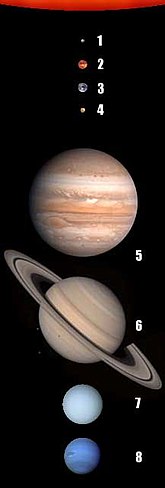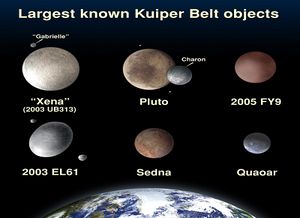Solar System
 From Rationalwiki
From Rationalwiki 
| It's not rocket science, it's... Astronomy |
| The Final Frontier |
|
| The abyss stares back |
v - t - e
|
The Solar System (sometimes stylized as "Sol System") consists of a star (the Sun), and the planets, moons, asteroids, comets, meteors and other objects gravitationally bound to it. Under the current International Astronomical Union definitions, there are four terrestrial or rocky planets, and four gas giants, as well a shedload of dwarf planets. The terrestrial planets are nearer to the Sun. As the Sun comprises 99.86% of the Solar System's mass, you might describe it as one yellow dwarf star and assorted debris.
In cosmic terms, it's sometimes addressed as a member of the Solar Interstellar Neighborhood, Milky Way Galaxy, Local Galactic Group, Virgo Supercluster, Laniakea Supercluster, Observable Universe.
Planets[edit]
In order of distance from the Sun the planets are:
- Mercury .39 AU
- Venus .72 AU
- Earth 1.0 AU
- Mars 1.5 AU
- Jupiter 5.2 AU
- Saturn 9.5 AU
- Uranus 19 AU
- Neptune 29 AU
1 AU (astronomical unit) = 149 598 000 kilometers
Dwarf planets[edit]

Pluto used to be considered a planet and will always be a planet in our hearts, but is now classified as a "dwarf planet" together with the former "minor planet" (asteroid) Ceres, the discord-producing Eris and some other objects in the Kuiper Belt. The rebranding of Pluto as a dwarf planet in 2006 was a minor pop science and media storm, with many traditionalists demanding that Pluto be kept as a planet. However, the reasoning behind the classification was the rate of discovery of new objects in the outer solar system. Each new object could have been classed as a planet, but undoubtedly this could lead to a considerable definition problem (prior to 2006, "planet" wasn't formally defined; there was no pressing need to until this point) with the minimum size of a "planet" shrinking until half the asteroids in the Solar System were included. At least one object, Eris, is known to be more massive than Pluto, and Ceres already had its planetary status revoked decades previously. "Plutoid" is a sub-category of distant dwarf planets to at least acknowledge Pluto as the first one discovered.
List of dwarf planets and dwarf planet candidates in order of increasing distance to the Sun, as of October 2011:
- Ceres, the former largest and first discovered (in 1801) asteroid
- Pluto, the former "ninth planet", discovered in 1930
- Charon, Pluto's largest moon, big enough to pull the system's barycenter into the empty space between Pluto and Charon, discovered in 1978.
- Albion, dwarf planet candidate. The second identified member of the Kuiper Belt, discovered in 1992.
- Orcus, dwarf planet candidate, discovered in 2004. May be even slightly closer to the Sun on average than Pluto.
- Haumea, discovered in 2004, accepted as a dwarf planet in 2008
- Quaoar, dwarf planet candidate, discovered in 2002
- Makemake, discovered in 2005, accepted as a dwarf planet in 2008
- Gonggong (a.k.a. 2007 OR10), dwarf planet candidate, discovered in 2007
- Eris (a.k.a. 2003 UB313 or "Xena"), discovered in 2005, accepted as a dwarf planet in 2006. It was called "the tenth planet" in the media for some time, driving Planet X believers
nutsnuttier. - Sedna, dwarf planet candidate, discovered in 2003. Really, really, really far away from the Sun. So far away that the eight known planets can not possibly be responsible for the eccentricity of its orbit.
As of 2006, the number of known dwarf planets climbed to 44.[1]
Asteroids[edit]
The Solar System is also home to hundreds of thousands of asteroids, concentrated mostly in a belt between Mars and Jupiter, as well as innumerable icy bodies in the outer reaches of the system, which become comets when they are perturbed into the inner system and made visible by evaporation of part of their bodies by the heat of the sun. Contrary to popular depictions, you can probably easily navigate through this with your eyes closed.
Kuiper belt[edit]
The Kuiper belt is a "disk" extending to around 50 AU from the Sun that contains thousands of small, icy planetoids, including Pluto. The Kuiper belt is believed to be the source of short-period comets.[2] According to Freeman Dyson, within a few centuries, humanity will have likely relocated there, at which time, we can expect Freeman Dyson to have learned how to use commas, correctly.
Scattered Disk[edit]
Former members of the Kuiper belt that were thrown into eccentric and heavily inclined orbits when they passed too close to Neptune in the distant past.
Detached Objects[edit]
Trans-Neptunian objects with highly eccentric and inclined orbits whose perihelia are too distant for Neptune to influence them, making them seem "detached" from the rest of the solar system. Examination of the orbits of several Detached Objects led to a testable, but as yet unproven, hypotheses of an undetected planet.
Oort cloud[edit]

Surrounding the solar system is an immense cloud of ice bodies called the Oort cloud. It lies roughly 50,000 AU from the sun or about a quarter of the way to Proxima Centauri, the nearest star to our system.[3] Its vast distance means that it is only loosely bound to the solar system and that it is easily disturbed by other stars. Such disturbances are believed to be the source of all long-period comets.
A disc-shaped cloud of comets occupies some of the space between the Oort cloud and the Kuiper belt. This inner cloud is called the Hills Cloud.
Formation and evolution[edit]
The Solar System was formed around 4.6 billion years ago from the collapse of a gas cloud,[notes 1] that as it contracted spun faster leaving a disk surrounding a dense central core. The latter would become the Sun once it had contracted enough to ignite hydrogen fusion and the former, the protoplanetary disk, was the place were planets would form. Planetary formation is thought to have taken place via accretion, with dust grains merging to form larger clumps, that would collide and fuse to form even larger clumps and so on. While in the inner Solar System temperatures were so high that just high-melting points elements and compounds remained, the four terrestrial planets forming from them, in the outer one low-melting ones (considerably more abundant than the former) were also present explaining why the four outer planets are more massive than the innermost ones.[notes 2] Planetary interactions with the remaining matter of the mentioned disk are thought to have changed the orbits of the planets, on a quite lively way for Jupiter,[notes 3] until they settled into their current ones. Those planetary dances stirred the remaining non-coalesced bodies (read: asteroids, comets, and similar debris) causing them to wreak havoc on the brand-new planets in the form of collisions. Once the supply of them was almost exhausted calm arrived to the Solar System, with just the occasional comet/asteroid impact here and there.
The future of the Solar System is tightly tied to that of the Sun. Things are not expected to change very much for the former as a whole the next billions of years.[notes 4] Once the Sun exhausts its central hydrogen 5 billion years from now things will become live again, most notably when it goes full red giant-mode 2.5 billion years later and before absorbing them roasts to Hell and back Mercury, Venus, and Earth with planets beyond the latter surviving but ending up more or less cooked too[4] and prospects looking very bleak for all those icy bodies of the outer Solar System[notes 5]. After burning helium on its core for a 100 million years and 20 million years of (a sort of) red giant again, the Sun will expel its outer layers as a planetary nebula leaving behind its cooling core, that will fade away as a black dwarf after many billions of years. The remaining planets are expected to orbit further away than now because of the Sun's heavy mass loss during its final stages,[notes 6] and finally it's expected that the gravity of passing stars will strip the dead Sun of them leaving it with no planets in around 1015 years, even if other research gives a much earlier time for the disappearance of the Solar System (roughly 100 billion years[5]).
External links[edit]
- Solar System Scale Model, a site-model of the Solar System where both the sizes and the distances to the Sun are on the same scale. Prepare for lots of scrolling; the page is estimated to be a half-mile wide on a standard 72 dpi screen.
- Bill Nye riding his bike along a scale model of the Solar System. "There's a lot of space in space!"
Notes[edit]
- ↑ Thought to have been caused by one or several nearby supernovae
- ↑ Moons would have formed either from disks surrounding the (four largest) planets, debris from collisions (Moon or Pluto's moon Charon), or gravitational capture of passing bodies-the countless outermost satellites of Jupiter-
- ↑ Highlights include: ruining the asteroid belt and the possibilities of a planet forming there, possibly a fifth large planet being expelled out of the Solar System, and even the destruction of a first generation of inner planets
 , from whose debris the terrestrial planets would have formed
, from whose debris the terrestrial planets would have formed
- ↑ Neither for the planets if one ignores things as the Earth eventually becoming unhabitable because of the Sun's increasing luminosity with time or Triton crashing into Neptune and forming a spectacular ring system around it. The future collision between the Milky Way and Andromeda galaxies
 it's highly unlikely that will affect "us" too
it's highly unlikely that will affect "us" too
- ↑ A side effect of the Sun's expansion and increasing luminosity will be the Solar System's habitable zone
 expanding outward. It will be in Mars' orbit once the Sun exhausts the hydrogen on its core but during peak red giant it will be in the Kuiper belt
expanding outward. It will be in Mars' orbit once the Sun exhausts the hydrogen on its core but during peak red giant it will be in the Kuiper belt
- ↑ Probably, however, the extensive mass loss suffered by the Sun during those late epochs will mess with planetary orbits so much that some planets could either collide among themselves or even with the Sun itself, or sent into space -asteroids and comets at the very least owing to their small mass are very likely to be affected-. See here
References[edit]
- ↑ The Dwarf Planets by Mike Brown
- ↑ Kuiper Belt, Solar System Exploration, NASA.
- ↑ Oort Cloud, Solar System Exploration, NASA.
- ↑ Jupiter will become a hot Jupiter: Consequences of Post-Main-Sequence Stellar Evolution on Gas Giant Planets
- ↑ The Great Inequality and the Dynamical Disintegration of the Outer Solar System
Categories: [Astronomy] [Planets]
↧ Download as ZWI file | Last modified: 02/22/2025 03:25:59 | 67 views
☰ Source: https://rationalwiki.org/wiki/Solar_System | License: CC BY-SA 3.0
 KSF
KSF